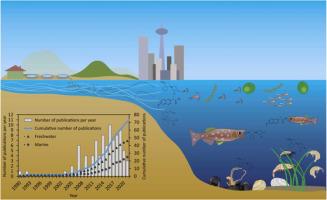Journal of Hazardous Materials ( IF 12.2 ) Pub Date : 2021-09-26 , DOI: 10.1016/j.jhazmat.2021.127350 Klaudia Świacka 1 , Jakub Maculewicz 2 , Dorota Kowalska 2 , Magda Caban 2 , Katarzyna Smolarz 1 , Justyna Świeżak 1

|
In the last decades an increasing number of studies has been published concerning contamination of aquatic ecosystems with pharmaceuticals. Yet, the distribution of these chemical compounds in aquatic environments raises many questions and uncertainties. Data on the presence of selected pharmaceuticals in the same water bodies varies significantly between different studies. Therefore, since early 1990 s, wild organisms have been used in research on environmental contamination with pharmaceuticals. Indeed, pharmaceutical levels measured in biological matrices may better reflect their overall presence in the aquatic environments as such levels include not only direct exposure of a given organisms to a specific pollutant but also processes such as bioaccumulation and biomagnification. In the present paper, data concerning occurrence of pharmaceuticals in aquatic biota was reviewed. So far, pharmaceuticals have been studied mainly in fish and molluscs, with only a few papers available on crustaceans and macroalgae. The most commonly found pharmaceuticals both in freshwater and marine organisms are antibiotics, antidepressants and NSAIDS while there is no information about the presence of anticancer drugs in aquatic organisms. Furthermore, only single studies were conducted in Africa and Australia. Hence, systematization of up-to-date knowledge, the main aim of this review, is needed for further research targeting.
中文翻译:

野生水生生物中药物及其代谢物的存在——知识现状
在过去的几十年中,越来越多的关于药物污染水生生态系统的研究发表。然而,这些化合物在水生环境中的分布引发了许多问题和不确定性。不同研究之间,同一水体中存在选定药物的数据存在显着差异。因此,自 1990 年代初以来,野生生物已被用于研究药物对环境的污染。事实上,在生物基质中测量的药物水平可能更好地反映它们在水生环境中的整体存在,因为这种水平不仅包括给定生物体直接暴露于特定污染物,还包括生物积累和生物放大等过程。在本论文中,审查了有关在水生生物群中出现药物的数据。迄今为止,药物研究主要针对鱼类和软体动物,只有几篇关于甲壳类动物和大型藻类的论文。淡水和海洋生物中最常见的药物是抗生素、抗抑郁药和非甾体抗炎药,而没有关于水生生物中存在抗癌药物的信息。此外,在非洲和澳大利亚只进行了一项研究。因此,需要对最新知识进行系统化,这是本次审查的主要目的,需要进一步研究目标。淡水和海洋生物中最常见的药物是抗生素、抗抑郁药和非甾体抗炎药,而没有关于水生生物中存在抗癌药物的信息。此外,在非洲和澳大利亚只进行了一项研究。因此,需要对最新知识进行系统化,这是本次审查的主要目的,需要进一步研究目标。淡水和海洋生物中最常见的药物是抗生素、抗抑郁药和非甾体抗炎药,而没有关于水生生物中存在抗癌药物的信息。此外,在非洲和澳大利亚只进行了一项研究。因此,需要对最新知识进行系统化,这是本次审查的主要目的,需要进一步研究目标。











































 京公网安备 11010802027423号
京公网安备 11010802027423号